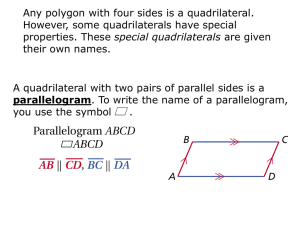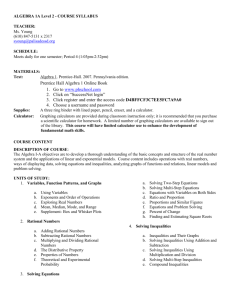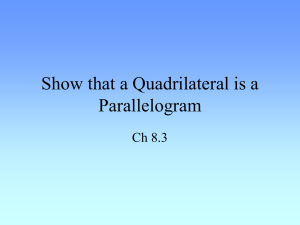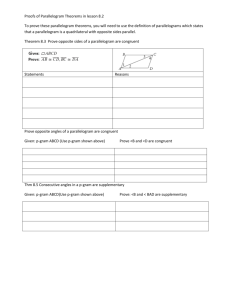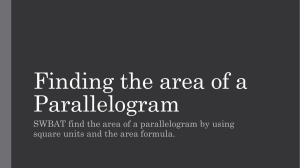Algebra 2 Lesson 2
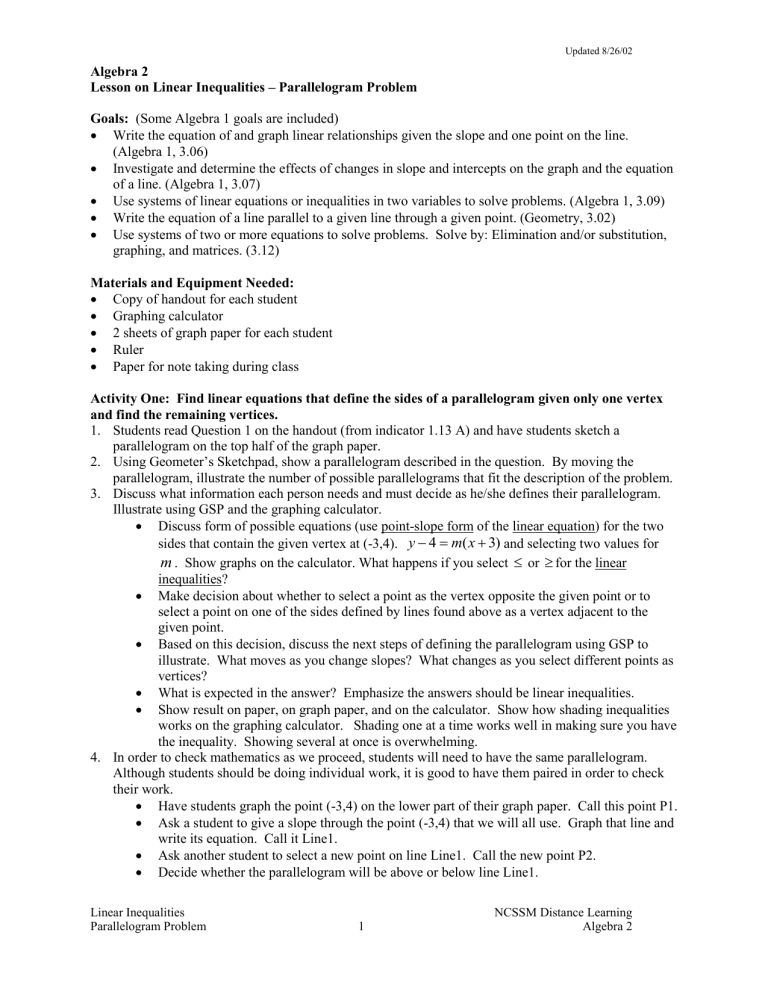
Updated 8/26/02
Algebra 2
Lesson on Linear Inequalities – Parallelogram Problem
Goals: (Some Algebra 1 goals are included)
Write the equation of and graph linear relationships given the slope and one point on the line.
(Algebra 1, 3.06)
Investigate and determine the effects of changes in slope and intercepts on the graph and the equation of a line. (Algebra 1, 3.07)
Use systems of linear equations or inequalities in two variables to solve problems. (Algebra 1, 3.09)
Write the equation of a line parallel to a given line through a given point. (Geometry, 3.02)
Use systems of two or more equations to solve problems. Solve by: Elimination and/or substitution, graphing, and matrices. (3.12)
Materials and Equipment Needed:
Copy of handout for each student
Graphing calculator
2 sheets of graph paper for each student
Ruler
Paper for note taking during class
Activity One: Find linear equations that define the sides of a parallelogram given only one vertex and find the remaining vertices.
1.
Students read Question 1 on the handout (from indicator 1.13 A) and have students sketch a parallelogram on the top half of the graph paper.
2.
Using Geometer’s Sketchpad, show a parallelogram described in the question. By moving the parallelogram, illustrate the number of possible parallelograms that fit the description of the problem.
3.
Discuss what information each person needs and must decide as he/she defines their parallelogram.
Illustrate using GSP and the graphing calculator.
Discuss form of possible equations (use point-slope form of the linear equation) for the two sides that contain the given vertex at (-3,4). y 4 (
3) and selecting two values for m . Show graphs on the calculator. What happens if you select
or
for the linear inequalities?
Make decision about whether to select a point as the vertex opposite the given point or to select a point on one of the sides defined by lines found above as a vertex adjacent to the given point.
Based on this decision, discuss the next steps of defining the parallelogram using GSP to illustrate. What moves as you change slopes? What changes as you select different points as vertices?
What is expected in the answer? Emphasize the answers should be linear inequalities.
Show result on paper, on graph paper, and on the calculator. Show how shading inequalities works on the graphing calculator. Shading one at a time works well in making sure you have the inequality. Showing several at once is overwhelming.
4.
In order to check mathematics as we proceed, students will need to have the same parallelogram.
Although students should be doing individual work, it is good to have them paired in order to check their work.
Have students graph the point (-3,4) on the lower part of their graph paper. Call this point P1.
Ask a student to give a slope through the point (-3,4) that we will all use. Graph that line and write its equation. Call it Line1.
Ask another student to select a new point on line Line1. Call the new point P2.
Decide whether the parallelogram will be above or below line Line1.
Linear Inequalities
Parallelogram Problem 1
NCSSM Distance Learning
Algebra 2
Updated 8/26/02
Ask a student to give a slope through point P2. Graph that line and write its equation. Call the new line Line2.
Discuss whether the parallelogram will be above or below line Line2.
At this point you can either find a line through P1 and parallel to Line2 or you can select a new point P3 on Line2 and find the line through P3 and parallel to Line1.
Proceed until all students have the same parallelogram.
5.
Give students an opportunity to write all the inequalities that describe the parallelogram.
6.
Use the flex cam to see what students are doing. Have several pairs of students show their work and progress.
7.
Once equations are complete, discuss how to find vertices of the parallelogram that have not yet been determined. Use both substitution and elimination methods of solving simultaneous equations.
8.
Show some parallelograms on GSP using the coordinates of the vertices and the graphing calculator using the linear inequalities. Show how to find points of intersection on the calculator.
Follow-Up Problem
Write the system of inequalities that describes a triangular region with one vertex at (7, 5) and another on the xaxis. None of the sides can be horizontal or vertical. Verify your result on your graphing calculator.
There are many correct answers to this question. A possible way for students to check work is to have work in pairs and have one student graph the systems of inequalities of the other student to determine if the system meets the criteria of the question.
Linear Inequalities
Parallelogram Problem 2
NCSSM Distance Learning
Algebra 2
Updated 8/26/02
Student Handout
Linear Inequalities with a Parallelogram
Algebra II
1.
Write a system of inequalities that defines the region enclosed by a parallelogram in the second quadrant with one vertex at (-3,4). The sides cannot be vertical or horizontal.
(This problem is taken from the Algebra II Indicators on the NCDPI website.)
2.
Find the vertices of the parallelogram described by this system of inequalities.
Linear Inequalities
Parallelogram Problem 3
NCSSM Distance Learning
Algebra 2
Updated 8/26/02
Follow-Up
Linear Inequalities
Algebra 2
1. Write the system of inequalities that describes a triangular region with one vertex at
(7, 5) and another on the x-axis. None of the sides can be horizontal or vertical. Verify your result on your graphing calculator.
(This problem is taken from the Algebra II Indicators on the NCDPI website.)
Linear Inequalities
Parallelogram Problem 4
NCSSM Distance Learning
Algebra 2
